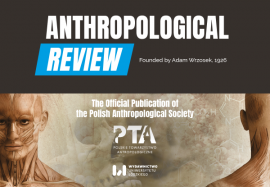Anthropological Review | VOL. 87 NO. 2 (2024)
Opublikowano: 11 lipca 2024

Anthropological Review (formerly “Przegląd Antropologiczny” and “Przegląd Antropologiczny – Anthropological Review”) is the official publication of the Polish Anthropological Society. It has had a long tradition of publication since its founding, in 1926, by Adam Wrzosek, an eminent Polish physical anthropologist and physician.
The journal is published quarterly with the financial support of the Ministry of Science and Higher Education of the Republic of Poland.
It publishes (since 1997) in English, and considers submissions of original research reports, overview articles, literature reviews, meta- analyses, short notes and communications. Manuscripts submitted to this journal must not be under simultaneous consideration by any other publisher and should not have been published elsewhere in substantially similar form. No part of a paper which has been published by Anthropological Review may be reproduced or published elsewhere without the written permission of the publisher.
The journal has open access; with the online version available here. Archival issues since 1992 are available on the PTA website. A hard copy of the journal is also published.
Although this journal is primarily directed at academics, students and PhD students, it is also beneficial for experts in other fields interested in utilizing modern biology in applied science and for practical pursuits in life.
The ancient people of Balinese: a study of health status based on paleopathology remains
Neni Trilusiana Rahmawati, Ashwin Prayudi, Rusyad Adi Suriyanto, Janatin Hastuti, Fidelis Aritona, Ati Rati Hidayah
Humans have been constantly exposed to the environment in their daily activities, which may result in some pathological changes. Paleopathology research is rare, particularly on ancient humans who lived in Bali, Indonesia. This research is intended to gain more insight into the history of diseases and the community in the past to assist future health researchers. This study was conducted to understand variation in disease among the ancient populations in Bali, Indonesia. The study examines skeletons from the Gilimanuk, Semawang, and Pacung Sembiran sites in Bali, Indonesia, collected from 1964 to 2008. A total of 336 individuals were identified, including 63 adult males, 75 adult females, and 56 adults whose sex could not be determined. In addition, 142 children were included in the analysis. The examination of the individuals revealed the presence of various dental pathological changes, such as caries and enamel hypoplasia, as well as periodontitis. Furthermore, several bone-related diseases and abnormalities were identified, such as osteophytes, fractures, porotic hyperostosis, and spina bifida occulta. Available evidence suggests a similarity in the types of pathological changes among the ancient populations of Gilimanuk, Semawang, and Pacung Sembiran. While a comprehensive explanation of the paleopathological variations observed in these populations necessitates further investigation, the present findings hold considerable value for medical experts and anthropologists seeking to better understand patterns of disease distribution among ancient Indonesian populations.
Hominin musical sound production: palaeoecological contexts and self domestication
Gary Clark, Arthur Saniotis, Robert Bednarik, Malin Lindahl, Maciej Henneberg
In this article we seek to integrate theories of music origins and dance with hominin fossil anatomy and the paleoecological contexts of hominin evolution. Based on the association between rhythm in music, dance and locomotion, we propose that early bipedal hominins may have evolved neurobiological substrates different from other great apes due to the rhythmic aspects of bipedal walking and running. Combined with the emancipation of the hands resulting from erect posture, we propose that the neurobiological changes necessary for technological innovation, cultural practices and human musical abilities may have evolved, at least in incipient form, much earlier than previously thought. The consequent ability to synchronize movement and sound production may have also proved beneficial as early bipedal hominins ventured out of late Miocene and early Pliocene woodland and forested habitats and into more open habitats with increased predation risk. We also postulate that, along with bipedalism, paedomorphic morphogenesis of the skull at the base of the hominin clade was a necessary prerequisite for the evolution of vocal modulation and singing in later varieties of hominin. To date research into the evolution of music and dance has yet to be integrated with the fossil and paleoecological evidence of early hominin evolution. This paper seeks to fill this lacuna in the extant literature on human evolution. We also suggest that autocatalytic feedback loops evolving synergistically with hominin erect posture, skull and hand morphology, neurochemical processes and the self-domestication syndrome, have been operative from early hominins some 6 Ma to the present. We document this process by reference to primatological, ethnographic, neurochemical and archaeological data.
Morphology and morphometry of frontal sinuses as a tool in sex determination based on 17th–18th century skulls from Poland
Kamil Mrożek, Justyna Marchewka, Beata Borowska, Alicja Budnik, Bartosz Leszczyński, Andrzej Wróbel, Iwona Wronka
Morphological analysis of the frontal sinuses (FS) is one of the methods used to assess the sex of human remains. Depending on the methods, the results indicate the effectiveness of using the FS in the assessment of sex at the level of 60–85.9%. Our goal was to determine whether the morphological and morphometric methods of sex assessment based on the FS can be used for examining historical populations in anthropological studies. We assessed FS both morphologically and morphometrically on a sample of 76 dry skulls (41 females and 35 males) from 17th–18th century form Poland to evaluate the potential of applying this method for sex estimation in human remains. A total of 76 X–rays were taken in both frontal and lateral views. The morphology and morphometry of the FS were assessed with ImageJ software. There were no significant differences between the sexes in assessing the outline of the upper border of the FS, as well as the number of partial septa. There was a statistically significant difference between the sexes in the width of the right FS, the height of the right and left FS, and the right and left area of the FS. The lateral view indicated a statistically significant difference between the sexes regarding the depth and area of the FS. The accuracy rate in classifying males and females using FS morphometry ranged from 59.09% to 69.57%. The FS in the lateral view (69.57%) and the height of the left FS in the frontal view (68.18%) are the most appropriate regressors for sex determination. Statistically significant differences in some FS measurements between the sexes do not appear to be a sufficient indicator of sex. Morphological and morphometrical characteristics of the FS should not be used as a guideline for sex assessment in the historical Polish population.
The anatomical bases of the 3D digital facial approximation of the Zlatý kůň 1 woman (ca. 43,000 BP)
Cicero Moraes, Francesco Maria Galassi, Luca Sineo , Jiří Šindelář , Elena Varotto, Joanna Mietlińska-Sauter , Nathalie Antunes-Ferreira , Michael E. Habicht, Thiago Beaini
In 1950 on Mount Zlatý kůň (‘Golden Horse’) in modern-day Czech Republic a system of caves was discovered. During many years of research in this area, human and animal osteological remains have been excavated, among which the most interesting ones were nine fragments of a female skull, now dated to ca. 43,000 yrs BP which are one of the earliest known anatomically modern humans in Eurasia. The aim of this research was to use purely digital techniques to: (1) to reconstruct the skull based on the 3D data of preserved fragments, (2) to approximate the probable appearance of the female it belonged to, and (3) to analyze the calculated shape of the reconstructed mandible and volume of the neurocranium in the context of similarities and differences with other representatives of the genus Homo. Computer techniques used in this research constitute a new, original approach to the problem of 3D analyses and may be useful primarily in bioarchaeological sciences, where metric analyses of the most valuable bone artifacts are often severely limited due to the incompleteness of the material available for research. The digital techniques presented here may also contribute significantly to the field of surgery, with the possibility of being adapted for applications in cranial prosthetics and post-traumatic reconstructive surgery.
Association between normal weight obesity and lipids profile in Slovak women aged 38 to 59 years
Daniela Ferjančeková, Petra Švábová, Alexandra Hozáková, Simona Sulis
Obesity and its associated health problems are an issue, especially when weight gain is not outwardly visible. Individuals with the same Body Mass Index (BMI) may differ in body fat percentage and may unknowingly suffer from normal weight obesity (NWO). Middle-aged women are at high risk if their body composition changes due to factors such as age, health status or reproductive history. This study investigated the relationship between NWO and lipid profile in middle-aged women. A sample of 122 women aged 38 to 59 years (47.17 ± 5.24) from Slovakia participated in this study. Using a questionnaire, participants answered questions about lifestyle, health background, sociodemographic classification, reproductive and menstrual history. The anthropometric parameters were determined using standard methods. Body composition was measured using a bioelectrical impedance analyzer. Biochemical parameters were determined from morning blood samples. Blood pressure was assessed in a sitting position using a digital sphygmomanometer. The primary aim of this study was to assess the differences in lipid profiles between NOW women and normal weight-lean (NWL) women. Our results showed statistically significantly higher values of uric acid in the women with NWO compared to NWL women (237.39 ± 54.11 μmol/l vs. 213.02 ± 52.64 μmol/l; p = 0.009). Moreover, significant differences were noted between NWO women and NWL women in body height, body weight, waist and hip circumference, WHR, BMI and fat mass (%, p < 0.05). Other biochemical variables showed no statistically significant differences between the study groups of women. Elevated uric acid levels in women diagnosed with NWO may serve as an indication of metabolic imbalance associated with undetected obesity. These results underscore the importance of implementing early detection and intervention methods for NWO to prevent related health issues. Further research is necessary to investigate the underlying factors contributing to these connections and evaluate the efficacy of customized interventions.
Revisiting the cranial variability of the Dmanisi hominins
Walter Neves, Maria Helena Senger, Leticia Valota, Mark Hubbe
The Dmanisi specimens represent the most diverse contemporaneous hominin fossils found at one single site and are key in understanding the first out -of- Africa dispersal and the origins of Homo erectus. Due to these reasons, they have]e been the focus of many studies in paleoanthropology in the last 30 years. However, there has not been any consensus on how to classify these fossils, nor has it been clarified how many species were co-living at that site. In this article, we aim to revisit the subject and contribute further to the discussion.
A review on association between menopausal symptoms and cardiovascular risk factors
Debasmita Kar, Subho Roy
Menopausal transition and post-menopausal periods can have short-term and long- term effects on mid-life health of women. The short-term effects include the possibility of experiencing of menopausal symptoms, while the long-term effects include cardiovascular diseases (CVD) risk. The occurrence of menopausal symptoms varies widely within and between populations. Studies indicate that the frequency and severity of menopausal symptoms are linked to CVD risk factors, but the existing literature is divergent and somewhat limited. Thus, women belonging to different populations are likely to be at a different risk of CVD, but the exact physiological mechanism behind this relationship remains unclear. The present narrative review aimed to synthesize the available evidence of menopausal symptoms in association with various conventional CVD risk factors such as blood pressure, total cholesterol and blood glucose levels and obesity, as well as to determine the potential link between these two processes. We undertook a rigorous data base search to identify, examine, and critically assess the existing literature on the associations between menopausal symptoms and CVD risk factors. We applied inclusion and exclusion criteria to filter the retrieved articles and classified the literature into eight major categories. The risk of CVD is higher among women who experience vasomotor, psychological, and urogenital symptoms compared to those who do not experience these symptoms. Our review indicates that menopausal symptoms can be used as markers in assessing CVD risk factors during midlife. Thus there is a need for larger-scale research to support these findings and identify the potential mediators that are controlling this association.
Association between expression level of the miR-320, miR-182, miR-223 and miR-486 and body composition among young Polish female volleyball players
Paulina Pruszkowska, Ireneusz Cichy, Zofia Ignasiak, Katarzyna Kochan, Marek Kociuba, Sławomir Kozieł, Anna Sebastjan, Marcin Ściślak, Elżbieta Żądzińska, Andrzej Rokita
The expression of circulating microRNAs appears to be a promising indicator of physical strength. The objective of this study was to determine whether there is an association between the expression level of four selected microRNAs and body composition over time among young female volleyball players. Blood samples and body composition measurements were taken from 7 females who are Polish volleyball players before and after 5 matches played out between the years 2017 and 2018. The blood spots were used to assess the expression of four microRNAs: miR-320, miR-182, miR-223, and miR-486. Fat mass, PFB% and BMI were positively correlated with expression level (exp.l) of miR-182. The miR-320 the exp.l was positively correlated with muscle mass and TBW. There were inverse correlations between miR-486 exp.l and PBF%, as well as between miR-486 exp.l and body mass, muscle mass, TBW, FFM, and BMR. Conversely, there were positive correlations between miR-486 exp.l and body mass and fat mass. The miR-182 may be positively correlated with fat tissue, miR-320 was positively correlated with muscle mass, and miR-486 was negatively correlated with fat mass. Overall, our study shows that the expression of miR-182, miR-320, and miR-486 is associated with body composition. The results of our study also suggest that exercise may decrease the level of miR-486.
Komentarze
Ten post dostępny jest także w języku: angielski





